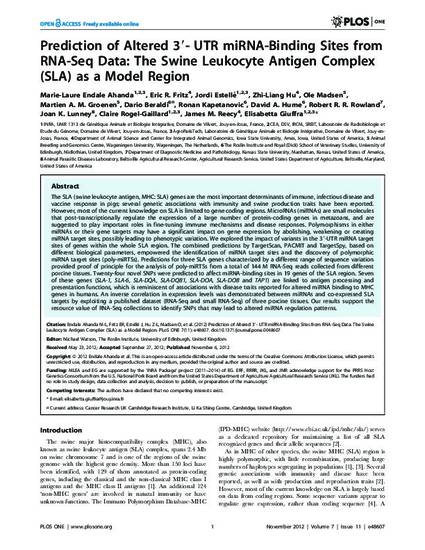
The SLA (swine leukocyte antigen, MHC: SLA) genes are the most important determinants of immune, infectious disease and vaccine response in pigs; several genetic associations with immunity and swine production traits have been reported. However, most of the current knowledge on SLA is limited to gene coding regions. MicroRNAs (miRNAs) are small molecules that post-transcriptionally regulate the expression of a large number of protein-coding genes in metazoans, and are suggested to play important roles in fine-tuning immune mechanisms and disease responses. Polymorphisms in either miRNAs or their gene targets may have a significant impact on gene expression by abolishing, weakening or creating miRNA target sites, possibly leading to phenotypic variation. We explored the impact of variants in the 3′-UTR miRNA target sites of genes within the whole SLA region. The combined predictions by TargetScan, PACMIT and TargetSpy, based on different biological parameters, empowered the identification of miRNA target sites and the discovery of polymorphic miRNA target sites (poly-miRTSs). Predictions for three SLA genes characterized by a different range of sequence variation provided proof of principle for the analysis of poly-miRTSs from a total of 144 M RNA-Seq reads collected from different porcine tissues. Twenty-four novel SNPs were predicted to affect miRNA-binding sites in 19 genes of the SLA region. Seven of these genes (SLA-1, SLA-6, SLA-DQA, SLA-DQB1, SLA-DOA, SLA-DOB and TAP1) are linked to antigen processing and presentation functions, which is reminiscent of associations with disease traits reported for altered miRNA binding to MHC genes in humans. An inverse correlation in expression levels was demonstrated between miRNAs and co-expressed SLA targets by exploiting a published dataset (RNA-Seq and small RNA-Seq) of three porcine tissues. Our results support the resource value of RNA-Seq collections to identify SNPs that may lead to altered miRNA regulation patterns.
Available at: http://works.bepress.com/james_reecy/54/

This article is from PLoS One 7 (2012): e48607, doi:10.1371/journal.pone.0048607.